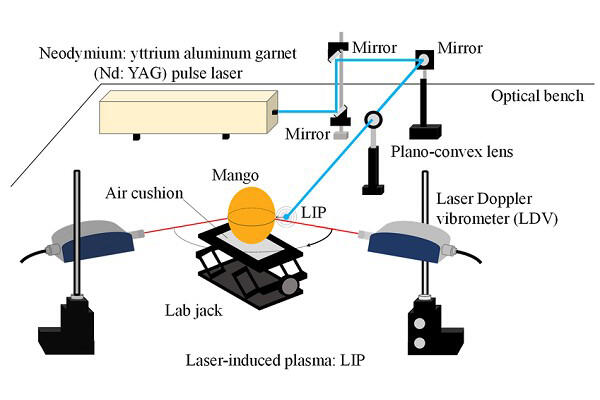Professor Naoki Hosoya, Engineering Science and Mechanics, Shibaura Institute of Technology, and Professor Itsuro Kajiwara of the Hokkaido University Graduate School, have developed a system to determine the optimal harvest timing for fruit by using Laser Induced Plasma (LIP) shock waves to check fruit quality without reducing its value, such as by touching or damaging it. The LIP shock waves cause the fruit to vibrate, generating Rayleigh waves on the skin surface. Observation of the changes in wave propagation speed enables the firmness (or ripeness) of the fruit to be determined. The results of the research were published in the Foods journal.
The ripeness of fruit correlates with its firmness, so mechanical methods to test fruit ripeness are considered effective for fruit that does not change color or smell. These mechanical methods typically involve devices that physically contact the fruit to test ripeness, such as using hammers or vibrating machines, with the resulting vibration response, or OS2 mode frequency, used to measure firmness.

The team found during previous research that evoking OS2 mode frequency vibrations with LIP shock waves enabled them to measure the firmness of apples without contact and without damaging the fruit. However, softer fruit, such as mangos, do not respond to OS2 mode frequency, so the team decided to test the correlation with firmness of Rayleigh waves as an alternative.
For their experiment, they carried out contactless measurement of LIP shock wave-generated Rayleigh waves on a sample of 20 Kent variety mangos using a laser doppler vibrometer. The experiment demonstrated that the wave propagation speed of the Rayleigh waves declined in correlation with the storage period of the mangos in days. Accordingly, it is now possible to evaluate the firmness of fruit without contact by generating Rayleigh waves on the skin with LIP shock waves and observing the wave propagation speed.
This article has been translated by JST with permission from The Science News Ltd.(https://sci-news.co.jp/). Unauthorized reproduction of the article and photographs is prohibited.




